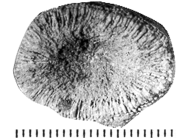Scleractinia taxon details
Gyroseris Reuss, 1854 †
1441515 (urn:lsid:marinespecies.org:taxname:1441515)
accepted
Genus
Gyroseris patellaris Reuss, 1854 † (type by monotypy)
Cyclastraea Alloiteau, 1952 † · unaccepted > junior subjective synonym
Pseudocycloseris Alloiteau, 1957 † · unaccepted > junior subjective synonym
marine, fresh, terrestrial
fossil only
Reuss, A. E. (1854). Beiträge zur Charakteristik der Kreideschichten in den Ostalpen, besonders im Gosauthale und am Wolfgangsee. <em>Denkschriften der Kaiserlichen Akademie der Wissenschaften, Mathematisch-naturwissenschafliche Classe.</em> 7: 1-156, errata, pls 1-31. Wien., available online at https://www.biodiversitylibrary.org/page/6343979 [details] 
Hoeksema, B. W.; Cairns, S. (2025). World List of Scleractinia. Gyroseris Reuss, 1854 †. Accessed at: https://www.marinespecies.org/Scleractinia/aphia.php?p=taxdetails&id=1441515 on 2025-05-11
Date
action
by
original description
Reuss, A. E. (1854). Beiträge zur Charakteristik der Kreideschichten in den Ostalpen, besonders im Gosauthale und am Wolfgangsee. <em>Denkschriften der Kaiserlichen Akademie der Wissenschaften, Mathematisch-naturwissenschafliche Classe.</em> 7: 1-156, errata, pls 1-31. Wien., available online at https://www.biodiversitylibrary.org/page/6343979 [details] 
original description (of Cyclastraea Alloiteau, 1952 †) Alloiteau J. (1952). Embranchement des Coelentérés. Madreporaires Post-Paleozoiques. <em>In: Piveteau J, ed. Traité de Paléontologie, Paris: Masson.</em> 539–684, pls. 1-10. [details]
original description (of Pseudocycloseris Alloiteau, 1957 †) Alloiteau J. (1957). Contribution à la systématique des Madréporaires fossiles. <em>Centre National de la Recherche Scientifique, Paris.</em> pp 462. [details]
context source (Hexacorallia) Fautin, Daphne G. (2013). Hexacorallians of the World. (look up in IMIS) [details]
additional source Milne Edwards H (1860) Histoire naturelle des coralliaires ou polypes proprement dits 3: 1-560. Librairie Encyclopédique de Roret, Paris. (look up in IMIS) [details]
additional source Duncan PM (1884) A revision of the families and genera of the sclerodermic Zoantharia, Ed. & H., or Madreporaria (M. Rugosa excepted). Journal of the Linnean Society of London, 18: 1-204. [details]
additional source Oppenheim P. (1930). Die Anthozoen der Gosauschichten in der Ostalpen. <em>Oppenheim, Berlin-Lichterfelde.</em> i-xviii, 1-576. [details]
original description (of Cyclastraea Alloiteau, 1952 †) Alloiteau J. (1952). Embranchement des Coelentérés. Madreporaires Post-Paleozoiques. <em>In: Piveteau J, ed. Traité de Paléontologie, Paris: Masson.</em> 539–684, pls. 1-10. [details]
original description (of Pseudocycloseris Alloiteau, 1957 †) Alloiteau J. (1957). Contribution à la systématique des Madréporaires fossiles. <em>Centre National de la Recherche Scientifique, Paris.</em> pp 462. [details]
context source (Hexacorallia) Fautin, Daphne G. (2013). Hexacorallians of the World. (look up in IMIS) [details]
additional source Milne Edwards H (1860) Histoire naturelle des coralliaires ou polypes proprement dits 3: 1-560. Librairie Encyclopédique de Roret, Paris. (look up in IMIS) [details]
additional source Duncan PM (1884) A revision of the families and genera of the sclerodermic Zoantharia, Ed. & H., or Madreporaria (M. Rugosa excepted). Journal of the Linnean Society of London, 18: 1-204. [details]
additional source Oppenheim P. (1930). Die Anthozoen der Gosauschichten in der Ostalpen. <em>Oppenheim, Berlin-Lichterfelde.</em> i-xviii, 1-576. [details]
 Present
Present  Inaccurate
Inaccurate  Introduced: alien
Introduced: alien  Containing type locality
Containing type locality
From editor or global species database
Diagnosis Solitary, patellate. Septa compact, distinctly granulated laterally, arranged radially in unequal systems. Columella papillose, well-developed. No synapticulae. Endothecal dissepiments thick, vesicular. Wall parathecal-epicostal. [details]Remark Wells (1956, p. F381) stated that Gyroseris was a junior synonym of the genus Trochoseris Milne Edwards and Haime, 1849a. However, fundamental differences can be seen in the development of both the septa and the wall. In Trochoseris synapticulae are abundant, forming a synapticulothecal wall and the septa are subcompact to porous (septa are compact and synapticulae absent in Gyroseris) [details]

